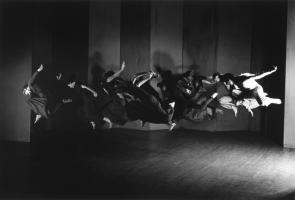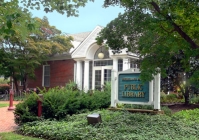Home » Posts tagged 'Sam Potts'
Tag Archives: Sam Potts
Lynchtown Revisited
“The twisted minds of bigots symbolized by twisted bodies. Dancers doubled up with rage and when the lynch mob finally dragged in its victim, they gathered about his body as if they were vultures.”- The New York Times
This past autumn, our Vice-President, Margaret O’Sullivan, traveled to New Jersey to start working with contemporary company Nimbus Dance Works. Under the direction of Samuel Pott, the company will be performing Weidman’s iconic work, Lynchtown, this winter in their NYC season February 15-17th at the Alvin Ailey Citigroup Theater.
Lynchtown was first performed in 1936 as the final section of Weidman’s trio suite Atavisms along side Bargain Counter and Stock Exchange. Lynchtown depits the excitement and horror of a lynching that Charles witnessed as a child. Unlike his previous and widely enjoyed comedic works, Lynchtown drew on a darker tone and “because Weidman was generally comic, his grave works had an anger and force that strengthened the sardonic, sometimes macabre dancing”. (American Modern Dancers: The Pioneers)
Because of it’s alarmingly honest essence, universal reach, and timeless topic, performances of Lynchtown have surfaced throughout the years. Most recently, Montclair State University dancers performed Weidman’s Lynchtown accompanied by live percussionists and clarinetist in a bill paired with Weidman’s Brahms Waltzes at the 92nd St Y in April 2011. Lynchtown was also shown in 1994 at the Humphrey-Weidman Gala: Dances from Their Years Together and in 1993 at SUNY Purchase and in Taiwan, China.
When asked about re-staging Lynchtown, Margaret O’Sullivan commented that “the hardest part for dancers is allowing themselves to really indulge and enjoy the grotesque and focus on the event. The dancers never face or look at the audience and it is very into the ground in very deep, deep plies.” She compares the movement to that of animals and recalls that in her first Lynchtown rehearsal as a dancer, Charles told them to be more “lascivious” with their movement.
One of the benefits and treats of learning Weidman dances from Margaret is the refreshingly “old” method of learning everything from memory. Nowadays, dancers develop and hone their skills in reversing movement learnt from a computer screen. Nimbus dancer Elena Valls expressed how in this Weidman Foundation/Nimbus collaboration, the dancers “did not learn anything from a video; it was all [Margaret’s] memory and from watching her do the movement. That made it way more enjoyable. She noticed the smallest details, like the Humphrey foot (which we call the Barbie foot), the tension in the hands and neck, and how your eyes really tell the story.”.
The company will be performing Lynchtown in their NYC season on February 15-17th at the Alvin Ailey Citigroup Theater. Director Sam Pott has plans to create a new work based off similar ideas and themes addressed in Weidman’s Lynchtown. Nimbus’s future plans involve traveling to New Jersey schools to show Weidman’s iconic work and have the children create their own versions of Weidman’s dance based on ideas of intolerance and hate.
For more information on the Nimbus Dance Works NYC performance, visit their website here.
Sources: Olga Maynard. American Modern Dancers The Pioneers. Copyright 1965.
Lynchtown quote taken from myloc.gov.
Post by Julia Jurgilewicz









